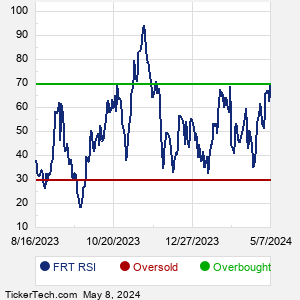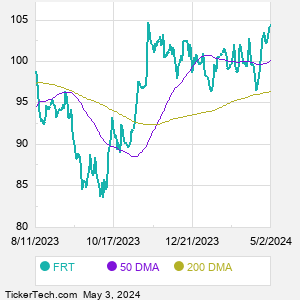Federal Realty Investment Trust is a holding company. Through its subsidiaries, Co. is an equity real estate investment trust focusing on the ownership, management, and redevelopment of retail and mixed-use properties located primarily in communities in selected metropolitan markets in the Northeast and Mid-Atlantic regions of the U.S., California, and South Florida. Co. owns or has a majority interest in community and neighborhood shopping centers and mixed-use properties which are operated as predominantly retail real estate projects.
When researching a stock like Federal Realty Investment Trust, many investors are the most familiar with Fundamental Analysis — looking at a company's balance sheet, earnings, revenues, and what's happening in that company's underlying business. Investors who use Fundamental Analysis to identify good stocks to buy or sell can also benefit from FRT Technical Analysis to help find a good entry or exit point. Technical Analysis is blind to the fundamentals and looks only at the trading data for FRT stock — the real life supply and demand for the stock over time — and examines that data in different ways. One of these ways is called the Relative Strength Index, or RSI. This popular indicator, originally developed in the 1970's by J. Welles Wilder, looks at a 14-day moving average of a stock's gains on its up days, versus its losses on its down days. The resulting FRT RSI is a value that measures momentum, oscillating between "oversold" and "overbought" on a scale of zero to 100. A reading below 30 is viewed to be oversold, which a bullish investor could look to as a sign that the selling is in the process of exhausting itself, and look for entry point opportunities. A reading above 70 is viewed to be overbought, which could indicate that a rally in progress is starting to get crowded with buyers. If the rally has been a long one, that could be a sign that a pullback is overdue. |



